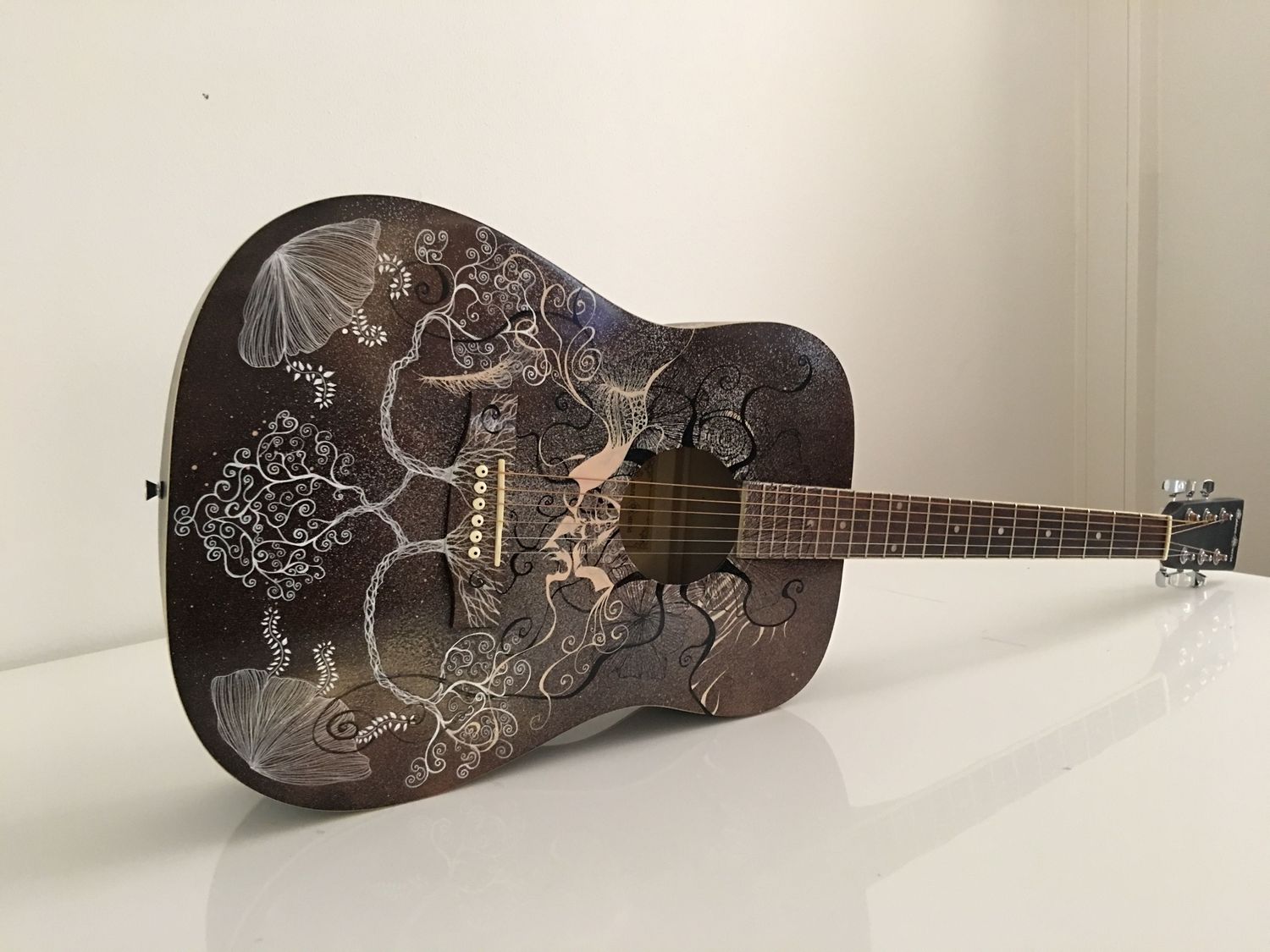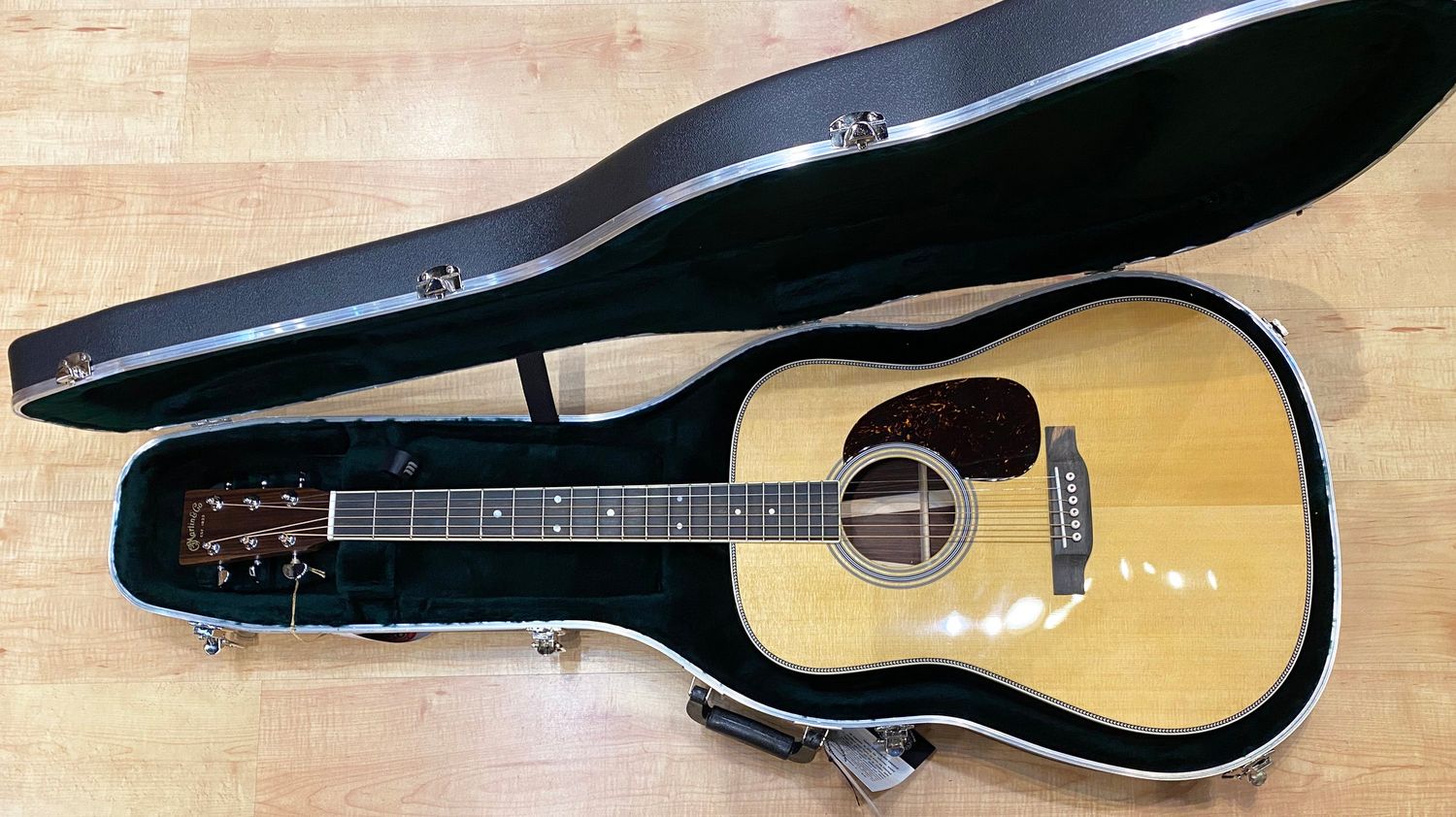Home>Production & Technology>Acoustic>How Does An Acoustic Guitar Work


Acoustic
How Does An Acoustic Guitar Work
Published: March 12, 2024
Discover how acoustic guitars produce sound and learn about the mechanics behind their unique resonance and tone. Explore the inner workings of acoustic guitars.
(Many of the links in this article redirect to a specific reviewed product. Your purchase of these products through affiliate links helps to generate commission for AudioLover.com, at no extra cost. Learn more)
Table of Contents
Introduction
The acoustic guitar is a beloved instrument that has captivated music enthusiasts for generations. Its timeless appeal lies in its ability to produce rich, resonant tones that evoke a wide range of emotions. Whether it's the gentle strumming of a folk ballad or the fiery picking of a bluegrass tune, the acoustic guitar's versatility knows no bounds.
In this article, we will delve into the inner workings of the acoustic guitar, exploring the fascinating mechanisms that bring forth its melodic charm. From the intricate interplay of strings to the acoustic properties of its wooden body, we will uncover the magic behind this iconic instrument.
Join us on a journey through the anatomy of the acoustic guitar, unraveling the secrets of sound production and the physics of string vibration. By the end of this exploration, you will gain a newfound appreciation for the acoustic guitar's remarkable ability to resonate with the human soul.
So, grab your pick and strum along as we embark on a captivating exploration of how an acoustic guitar works.
Anatomy of an Acoustic Guitar
The acoustic guitar is a marvel of craftsmanship, blending artistry and engineering to create a harmonious instrument. Let's dissect its anatomy to understand the role each component plays in producing its distinctive sound.
-
Body: The body of an acoustic guitar is typically crafted from tonewoods such as spruce, cedar, mahogany, or rosewood. Its shape and size, ranging from dreadnought to concert, influence the instrument's resonance and tonal characteristics. The soundhole, often adorned with an ornate rosette, allows sound to escape from the body, contributing to the guitar's projection.
-
Neck and Fretboard: The neck extends from the body and is usually made of sturdy hardwood, providing support for the strings and fretboard. The fretboard, often constructed from rosewood or ebony, features frets that divide the neck into precise intervals, enabling the player to produce different pitches.
-
Headstock and Tuning Pegs: The headstock houses the tuning pegs, which are used to adjust the tension of the strings. This critical function allows the guitarist to tune the instrument to the desired pitches, ensuring optimal sound quality.
-
Bridge and Saddle: The bridge serves as an anchor for the strings, transmitting their vibrations to the body. The saddle, positioned on the bridge, plays a role in setting the guitar's intonation, ensuring that each note rings true along the fretboard.
-
Strings: Typically made of steel or nylon, the strings are the heart of the acoustic guitar. When plucked or strummed, they vibrate and produce sound waves that resonate within the body, creating the guitar's distinctive timbre.
-
Bracing: Inside the body, delicate bracing patterns, often made of spruce or other tonewoods, provide structural support and influence the guitar's tonal characteristics. These internal reinforcements help distribute the vibrations across the soundboard, contributing to the instrument's resonance.
Understanding the intricate interplay of these components illuminates the acoustic guitar's remarkable design. Each element contributes to the instrument's overall sound and playability, showcasing the meticulous craftsmanship and attention to detail that define this beloved musical companion.
Sound Production
The enchanting sound of an acoustic guitar emanates from a complex interplay of physical phenomena, culminating in a symphony of vibrations that captivate the senses. Understanding the process of sound production within this iconic instrument unveils the intricate mechanics that give rise to its melodic allure.
When a guitarist plucks a string, it sets off a chain reaction of events that ultimately produce the resonant tones we cherish. As the string is set into motion, it undergoes rapid oscillations, generating sound waves that propagate through the surrounding air. These waves travel through the soundhole and interact with the guitar's body, initiating a phenomenon known as resonance.
The wooden body of the acoustic guitar serves as a resonant chamber, amplifying and shaping the sound waves produced by the vibrating strings. The tonewoods used in crafting the body, such as spruce, cedar, or mahogany, contribute to the instrument's unique tonal characteristics. The sound waves reverberate within the body, bouncing off its internal surfaces and merging to create a rich, full-bodied sound that defines the acoustic guitar's signature timbre.
Furthermore, the internal bracing of the guitar's body plays a pivotal role in sound production. The delicate bracing patterns, meticulously designed and strategically positioned, serve to reinforce the structural integrity of the instrument while influencing its acoustic properties. By distributing the vibrations across the soundboard, the bracing enhances the guitar's resonance, ensuring that the sound produced is robust and well-balanced.
In addition to the body's contribution to sound production, the strings themselves are fundamental to the acoustic guitar's sonic tapestry. The choice of string material, whether steel or nylon, significantly impacts the instrument's tonal palette. The strings' tension, gauge, and composition all influence the character of the sound, allowing for a diverse range of expressive possibilities.
As the vibrations from the strings interact with the resonant chamber of the guitar's body, a harmonious dialogue ensues, giving rise to the captivating melodies that have enraptured audiences for centuries. The acoustic guitar's sound production is a testament to the harmonious fusion of art and science, where craftsmanship and physics converge to create an instrument that speaks to the soul through its enchanting music.
String Vibration
The mesmerizing sound of an acoustic guitar is intricately linked to the physics of string vibration. When a guitarist plucks a string, it sets in motion a captivating dance of oscillations that give rise to the instrument's melodic charm.
At the heart of string vibration lies the fundamental principle of tension and mass. When a string is plucked, it is displaced from its resting position and then released, causing it to snap back and forth. This rapid back-and-forth motion generates waves that propagate along the length of the string, creating sound waves that travel through the air and reach our ears.
The pitch of the note produced is determined by the frequency of the string's vibration, which is influenced by factors such as its length, tension, and mass per unit length. By altering these variables, a guitarist can produce a diverse range of pitches, allowing for expressive melodies and harmonies to unfold.
The length of the vibrating portion of the string, determined by the placement of the player's fingers on the fretboard, directly impacts the pitch produced. Shortening the vibrating length raises the pitch, while lengthening it lowers the pitch, providing the guitarist with a means to navigate the musical landscape with precision.
Moreover, the tension applied to the string, achieved through tuning pegs, plays a pivotal role in shaping the character of the sound. Higher tension results in higher pitch, while lower tension yields lower pitch, offering a spectrum of tonal possibilities for the guitarist to explore.
Additionally, the mass per unit length of the string influences its vibrational behavior. Thicker, heavier strings produce lower pitches, while thinner, lighter strings generate higher pitches, allowing for nuanced tonal variations that enrich the acoustic guitar's sonic palette.
As the strings vibrate, they impart their energy to the guitar's body, setting the stage for the resonant chamber to amplify and shape the sound waves. This symbiotic relationship between string vibration and resonance gives rise to the acoustic guitar's captivating voice, weaving a tapestry of melodies that resonate with the human spirit.
In essence, the enchanting interplay of tension, mass, and length in string vibration forms the cornerstone of the acoustic guitar's sonic identity, infusing each note with a depth of emotion and expression that transcends language. It is through this harmonious dance of vibrations that the acoustic guitar finds its voice, speaking to the hearts of listeners with its timeless melodies.
Resonance and Amplification
Resonance and amplification are pivotal to the captivating sound produced by an acoustic guitar. The intricate interplay of string vibration and the resonant chamber of the guitar's body sets the stage for a mesmerizing symphony of tones that enrapture listeners.
When a guitarist plucks a string, it sets off a cascade of vibrations that interact with the wooden body of the guitar. This interaction gives rise to a phenomenon known as resonance, wherein the body of the guitar vibrates sympathetically with the strings, amplifying and enriching the sound waves produced. The resonant chamber of the guitar serves as a natural amplifier, enhancing the volume and projection of the instrument's voice.
The choice of tonewoods for the guitar's body plays a crucial role in shaping its resonant properties. Tonewoods such as spruce, cedar, mahogany, and rosewood are prized for their unique acoustic characteristics, influencing the timbre and resonance of the instrument. The density, stiffness, and internal damping of these tonewoods contribute to the guitar's ability to resonate and project sound with clarity and warmth.
Furthermore, the internal bracing of the guitar's body serves to optimize its resonance and amplification. Delicately crafted bracing patterns, strategically positioned beneath the soundboard, reinforce the structural integrity of the instrument while influencing its acoustic properties. By distributing the vibrations across the soundboard, the bracing enhances the guitar's resonance, ensuring that the sound produced is robust and well-balanced.
As the resonant chamber of the guitar amplifies the vibrations from the strings, the resulting sound waves reverberate within the body, merging and interacting to create a rich, full-bodied tone. The soundhole, a distinctive feature of the acoustic guitar, also contributes to the amplification process by allowing sound to escape from the body, further enhancing the instrument's projection and presence.
In essence, resonance and amplification form the cornerstone of the acoustic guitar's sonic identity, elevating its melodic expressions to new heights. The harmonious interplay of string vibration, resonant chamber, tonewoods, and bracing culminates in a symphony of sound that transcends the boundaries of the instrument, captivating audiences with its timeless allure.
The acoustic guitar's ability to harness the power of resonance and amplification exemplifies the artistry and engineering that converge to create an instrument that speaks to the soul through its enchanting music.
Conclusion
In conclusion, the acoustic guitar stands as a testament to the harmonious fusion of artistry and physics, captivating audiences with its timeless melodies and enchanting resonance. From its meticulously crafted body to the intricate dance of string vibration, the acoustic guitar embodies a symphony of craftsmanship and sonic beauty.
The anatomy of the acoustic guitar, with its resonant tonewoods, precise fretboard, and delicate bracing, showcases the meticulous attention to detail that defines this beloved instrument. Each component plays a crucial role in shaping the guitar's sound, contributing to its rich tonal palette and expressive capabilities.
The process of sound production within the acoustic guitar unveils the captivating interplay of physical phenomena, where vibrating strings interact with the resonant chamber of the guitar's body to create a symphony of sound. The resonant properties of tonewoods and the amplifying effects of the guitar's body serve to enrich the music, elevating each note to new heights of clarity and warmth.
Furthermore, the physics of string vibration form the cornerstone of the acoustic guitar's sonic identity, allowing for a diverse range of pitches and tonal variations. The harmonious dance of tension, mass, and length in string vibration gives rise to the instrument's expressive voice, speaking to the hearts of listeners with its depth of emotion and resonance.
Resonance and amplification, pivotal to the acoustic guitar's captivating sound, exemplify the artistry and engineering that converge to create an instrument that transcends mere musicality. The resonant chamber, tonewoods, and internal bracing work in unison to amplify and shape the sound waves, culminating in a symphony of tones that enrapture audiences with their timeless allure.
In essence, the acoustic guitar's remarkable ability to resonate with the human spirit is a testament to the enduring legacy of this iconic instrument. Its melodic charm and expressive capabilities continue to inspire musicians and captivate listeners, ensuring that the acoustic guitar remains a cherished companion in the world of music for generations to come.











